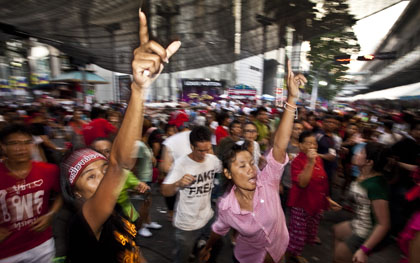New York Times reporter Thomas Fuller was literally in the line of fire on Thursday when a dissident Thai soldier he was interviewing was shot in the head and severely wounded mid-conversation.
Maj. Gen. Khattiya Sawatdiphol heads a paramilitary wing of the United Front for Democracy Against Dictatorship (UDD) anti-government protest group that has occupied different parts of the national capital for the past two months. According to the New York Times report, Fuller was standing just a couple feet away from Khattiya when he heard a “loud bang” and the fatigue-wearing soldier fell to the ground.
Government officials had earlier branded Khattiya as a “terrorist” for his alleged role in recent protest-related violence. Fuller’s eyewitness account of the shooting underscores the rising risks reporters face in covering Thailand’s escalating political conflict, which has resulted in some 26 deaths and over 900 injuries since the current round of street protests began on March 12.
A week ago, Fuller and I shared drinks to discuss politics and the deteriorating security situation journalists now face as Bangkok has morphed into an armed conflict zone. Fuller told me that he and his local news assistant had ducked behind a cement barrier when soldiers and protesters started to exchange gunfire and grenades exploded in the early evening of April 10.
They emerged unharmed from that night’s firefight, but Reuters cameraman Hiro Muramoto was killed by a bullet fired from a high velocity rifle. CPJ is currently investigating the circumstances surrounding his death, which both the government and UDD have blamed on each other. Both Fuller and Muramoto had reported from other conflict zones, but the unpredictable nature of Thailand’s armed and dangerous street fight is putting even the most seasoned reporters in high-risk situations.
Many freelance reporters and photographers, who contribute to a wide range of international publications and are often present at the UDD’s crudely barricaded protest site, lack the training and equipment needed to mitigate risks to their security.
The Thai government has attempted to block people from entering the square-mile protest area, while the UDD requires that reporters show press credentials to enter the site’s main stage. But until both sides make a stronger commitment to protecting reporters, and as the conflict appears to enter a dangerous new phase, more journalist casualties and injuries seem inevitable.
